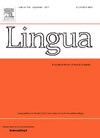希伯来语中非正典的一致性模式
IF 1.3
3区 文学
0 LANGUAGE & LINGUISTICS
引用次数: 0
摘要
本研究考察了希伯来语中的一种非规范结构:一个由头名词和定语形容词组成的定NP,其中头不加定冠词,但形容词加定冠词。这种结构偏离了希伯来语语法的标准规则,该规则要求名词和形容词之间的明确标记一致。分析是基于从过渡时期的十二个希伯来语作品的语料库和地址在古典希伯来语和过渡时期后期的希伯来语的结构。研究结果表明,从前一个时期,希伯来语是一种口语,到后一个时期,当它主要成为一种书面语言时,这种转变影响了这种结构的分布和潜在因素。此外,从中世纪到现代的过渡时期,中间时期的两个不同时期,对希伯来语产生了重大影响,促进了语言的发展和变化,甚至在希伯来语重新获得口语地位之前。这项研究展示了单一的语言现象是如何从多种因素中产生的,反映了几个世纪以来塑造希伯来语及其使用者的历史和文化变革。本文章由计算机程序翻译,如有差异,请以英文原文为准。
Non-canonical patterns of definiteness agreement in Hebrew
This study examines a non-canonical construction in Hebrew: a definite NP consisting of a head noun and an attributive adjective, where the head is not marked with a definite article but the adjective is. This construction deviates from the standard rules of Hebrew grammar, which require agreement in definiteness marking between the noun and its adjective. The analysis is based on a corpus of twelve Hebrew works from the Interim Period and addresses the construction in both Classical Hebrew and the Hebrew of the late Interim Period. The findings reveal that the transition from the former period, when Hebrew was a spoken language, to the latter, when it became predominantly a written language, influenced the distribution and underlying factors of this construction. Furthermore, the transition from the Middle Ages to the Modern Era, two distinct periods within the Interim Period, significantly impacted the Hebrew language, fostering linguistic development and change, even before Hebrew regained its status as a spoken language. The study demonstrates how a single linguistic phenomenon can arise from diverse factors, reflecting the historical and cultural transformations that shaped Hebrew and its speakers over the centuries.
求助全文
通过发布文献求助,成功后即可免费获取论文全文。
去求助
来源期刊

Lingua
Multiple-
CiteScore
2.50
自引率
9.10%
发文量
93
审稿时长
24 weeks
期刊介绍:
Lingua publishes papers of any length, if justified, as well as review articles surveying developments in the various fields of linguistics, and occasional discussions. A considerable number of pages in each issue are devoted to critical book reviews. Lingua also publishes Lingua Franca articles consisting of provocative exchanges expressing strong opinions on central topics in linguistics; The Decade In articles which are educational articles offering the nonspecialist linguist an overview of a given area of study; and Taking up the Gauntlet special issues composed of a set number of papers examining one set of data and exploring whose theory offers the most insight with a minimal set of assumptions and a maximum of arguments.
 求助内容:
求助内容: 应助结果提醒方式:
应助结果提醒方式:


